Serum TLR2 and TLR9 in Prostate Cancer Patients in Relation to EBV Status
Abstract
:1. Introduction
2. Results
2.1. Analysis of Selected Parameters of Patients with PCa and the Control Group
2.2. Evaluation of the Level of TLR-2 and TLR-9 in PCa Patients Compared to the Control Group
2.3. Evaluation of the Level of TLR-2 and TLR-9 in EBV-Positive PCa Patients in Relation to Risk Group
2.4. Evaluation of the Level of TLR-2 and TLR-9 in EBV(+) PCa Patients in Relation to the GS
2.5. Evaluation of the Level of TLR-2 and TLR-9 in EBV(+) PCa Patients in Relation to the T Feature
2.6. Correlation between Both Analysed TLRs and Selected Anti-EBV Antibodies
3. Discussion
4. Materials and Methods
4.1. Patient Characteristics
4.2. Clinical Specimens
4.3. Sample Collection
4.4. Isolation and Detection of EBV DNA
4.5. Identification of Antibodies against EBV
4.6. TLR-2 and TLR-9
4.7. Statistical Analysis
4.8. Ethics
5. Conclusions
Supplementary Materials
Author Contributions
Funding
Institutional Review Board Statement
Informed Consent Statement
Data Availability Statement
Conflicts of Interest
References
- World Health Organization. The Global Cancer Observatory—All Rights Reserved. December 2020. Available online: https://gco.iarc.fr/today/data/factsheets/cancers/27-Prostate-fact-sheet.pdf (accessed on 20 April 2024).
- Bray, F.; Laversanne, M.; Sung, H.; Ferlay, J.; Siegel, R.L.; Soerjomataram, I.; Jemal, A. Global cancer statistics 2022: GLOBOCAN estimates of incidence and mortality worldwide for 36 cancers in 185 countries. CA Cancer J. Clin. 2024, 74, 229–263. [Google Scholar]
- Prostate Cancer—Is It Worth Getting Tested? Available online: https://pacjent.gov.pl (accessed on 20 April 2024).
- Rawla, P. Epidemiology of Prostate Cancer. World J. Oncol. 2019, 10, 63–89. [Google Scholar] [PubMed]
- Wardecki, D.; Dołowy, M. Rak prostaty—Aktualne możliwości terapeutyczne. Farm. Pol. 2022, 78, 268–276. [Google Scholar]
- Ahmed, K.; Sheikh, A.; Fatima, S.; Haider, G.; Ghias, K.; Abbas, F.; Mughal, N.; Abidi, S.H. Detection and characterization of latency stage of EBV and histopathological analysis of prostatic adenocarcinoma tissues. Sci. Rep. 2022, 12, 10399. [Google Scholar]
- Leitzmann, M.F.; Rohrmann, S. Risk factors for the onset of prostatic cancer: Age, location, and behavioral correlates. Clin. Epidemiol. 2012, 4, 1–11. [Google Scholar] [PubMed]
- Pereira, N.M.; Martins, E.A.C.; Quintela, M.G.; Cunha, A.A.D.; Santos Netto, M.M.D.; Waisberg, J. Presence of HPV in prostate tissue from patients submitted to prostate biopsy. Acta Cir. Bras. 2023, 37, e371205. [Google Scholar]
- Abidi, S.H.; Bilwani, F.; Ghias, K.; Abbas, F. Viral etiology of prostate cancer: Genetic alterations and immune response. A literature review. Int. J. Surg. 2018, 52, 136–140. [Google Scholar]
- Ge, X.; Wang, X.; Shen, P. Herpes simplex virus type 2 or human herpesvirus 8 infection and prostate cancer risk: A meta-analysis. Biomed. Rep. 2013, 1, 433–439. [Google Scholar]
- Mundo, L.; Leoncini, L.; Accardi-Gheit, R. Epstein–Barr Virus Infection in Cancer. Cancers 2023, 15, 4659. [Google Scholar] [CrossRef] [PubMed]
- Chakravorty, S.; Afzali, B.; Kazemian, M. EBV-associated diseases: Current therapeutics and emerging technologies. Front. Immunol. 2022, 13, 1059133. [Google Scholar]
- Jangra, S.; Yuen, K.-S.; Botelho, M.G.; Jin, D.-Y. Epstein–Barr Virus and Innate Immunity: Friends or Foes? Microorganisms 2019, 7, 183. [Google Scholar] [CrossRef] [PubMed]
- Kawai, T.; Akira, S. Toll-like receptors and their crosstalk with other innate receptors in infection and immunity. Immunity 2011, 34, 637–650. [Google Scholar]
- Vijay, K. Toll-like receptors in immunity and inflammatory diseases: Past, present, and future. Int. Immunopharmacol. 2018, 59, 391–412. [Google Scholar]
- Duan, T.; Du, Y.; Xing, C.; Wang, H.Y.; Wang, R.-F. Toll-Like Receptor Signaling and Its Role in Cell-Mediated Immunity. Front. Immunol. 2022, 13, 812774. [Google Scholar]
- Ruuskanen, M.; Leivo, I.; Minn, H.; Vahlberg, T.; Haglund, C.; Hagström, J.; Irjala, H. Expression of toll-like receptors in non-endemic nasopharyngeal carcinoma. BMC Cancer 2019, 19, 624. [Google Scholar]
- Rex, V.; Zargari, R.; Stempel, M.; Halle, S.; Brinkmann, M.M. The innate and T-cell mediated immune response during acute and chronic gammaherpesvirus infection. Front. Cell. Infect. Microbiol. 2023, 13, 1146381. [Google Scholar]
- Li, L.; Liu, Q.; Le, C.; Zhang, H.; Liu, W.; Gu, Y.; Yang, J.; Zhang, X. Toll-like receptor 2 deficiency alleviates acute pancreatitis by inactivating the NF-κB/NLRP3 pathway. Int. Immunopharmacol. 2023, 121, 110547. [Google Scholar] [PubMed]
- Alzahrani, B. The Biology of Toll-Like Receptor 9 and Its Role in Cancer. Crit. Rev. Eukaryot. Gene Expr. 2020, 30, 457–474. [Google Scholar] [PubMed]
- Zauner, L.; Nadal, D. Understanding TLR9 action in Epstein-Barr virus infection. Front. Biosci. 2012, 17, 1219–1231. [Google Scholar]
- Zhao, S.; Zhang, Y.; Zhang, Q.; Wang, F.; Zhang, D. Toll-like receptors and prostate cancer. Front. Immunol. 2014, 5, 352. [Google Scholar]
- Kiś, J.; Góralczyk, M.; Sikora, D.; Stępień, E.; Drop, B.; Polz-Dacewicz, M. Can the Epstein–Barr Virus Play a Role in the Development of Prostate Cancer? Cancers 2024, 16, 328. [Google Scholar] [CrossRef] [PubMed]
- Wang, A.; Zhang, W.; Jin, M.; Zhang, J.; Li, S.; Tong, F.; Zhou, Y. Differential expression of EBV proteins LMP1 and BHFR1 in EBV-associated gastric and nasopharyngeal cancer tissues. Mol. Med. Rep. 2016, 13, 4151–4158. [Google Scholar] [PubMed]
- Agolli, A.; Ishak, A.; Viswanathan, M.; Co, E.L.; Shivakumar, J.; Agolli, O. Epstein-Barr Viral Infection and the Risk for Breast Cancer: A Systematic Review. Int. J. Hematol. Oncol. Stem Cell Res. 2023, 17, 114–124. [Google Scholar] [PubMed]
- Chijioke, O.; Azzi, T.; Nadal, D.; Münz, C. Innate immune responses against Epstein Barr virus infection. J. Leukoc. Biol. 2013, 94, 1185–1190. [Google Scholar] [PubMed]
- Nahand, J.S.; Khanaliha, K.; Mirzaei, H.; Moghoofei, M.; Baghi, H.B.; Esghaei, M.; Khatami, A.R.; Fatemipour, M.; Bokharaei-Salim, F. Possible role of HPV/EBV coinfection in anoikis resistance and development in prostate cancer. BMC Cancer 2021, 21, 926. [Google Scholar]
- Whitaker, N.J.; Glenn, W.K.; Sahrudin, A.; Orde, M.M.; Delprado, W.; Lawson, J.S. Human papillomavirus and Epstein Barr virus in prostate cancer: Koilocytes indicate potential oncogenic influences of human papillomavirus in prostate cancer. Prostate 2013, 73, 236–241. [Google Scholar] [PubMed]
- Grinstein, S.; Preciado, M.V.; Gattuso, P.; Chabay, P.A.; Warren, W.H.; De Matteo, E.; Gould, V.E. Demonstration of Epstein-Barr virus in carcinomas of various sites. Cancer Res. 2002, 62, 4876–4878. [Google Scholar] [PubMed]
- Morales-Sánchez, A.; Fuentes-Pananá, E.M. Human viruses and cancer. Viruses 2014, 6, 4047–4079. [Google Scholar] [CrossRef] [PubMed]
- Żuk-Wasek, A. Charakterystyka białek wirusa Epsteina-Barr—Ich udział w zakażeniu latentnym i powiązanie z procesami nowotworzenia. Postępy Mikrobiol. 2012, 51, 191–201. [Google Scholar]
- Perri, F.; Sabbatino, F.; Ottaiano, A.; Fusco, R.; Caraglia, M.; Cascella, M.; Longo, F.; Rega, R.A.; Salzano, G.; Pontone, M.; et al. Impact of Epstein Barr Virus Infection on Treatment Opportunities in Patients with Nasopharyngeal Cancer. Cancers 2023, 15, 1626. [Google Scholar] [CrossRef]
- Bai, L.; Li, W.; Zheng, W.; Xu, D.; Chen, N.; Cui, J. Promising targets based on pattern recognition receptors for cancer immunotherapy. Pharmacol. Res. 2020, 159, 105017. [Google Scholar]
- Mrozek-Gorska, P.; Buschle, A.; Pich, D.; Schwarzmayr, T.; Fechtner, R.; Scialdone, A.; Hammerschmidt, W. Epstein-Barr virus reprograms human B lymphocytes immediately in the prelatent phase of infection. Proc. Natl. Acad. Sci. USA 2019, 116, 16046–16055. [Google Scholar] [PubMed]
- Stevens, V.L.; Hsing, A.W.; Talbot, J.T.; Zheng, S.L.; Sun, J.; Chen, J.; Thun, M.J.; Xu, J.; Calle, E.E.; Rodriguez, C. Genetic variation in the toll-like receptor gene cluster (TLR10-TLR1-TLR6) and prostate cancer risk. Int. J. Cancer 2008, 123, 2644–2650. [Google Scholar]
- Malekghasemi, S.; Majidi, J.; Baradaran, B.; Aghebati-Maleki, L. Prostate cancer cells modulate the differentiation of THP-1 cells in response to etoposide and TLR agonists treatments. Cell Biol. Int. 2020, 10, 2031–2041. [Google Scholar]
- Mandal, R.K.; George, G.P.; Mittal, R.D. Association of Toll-like receptor (TLR) 2, 3 and 9 genes polymorphism with prostate cancer risk in North Indian population. Mol. Biol. Rep. 2012, 39, 7263–7269. [Google Scholar] [PubMed]
- Gaudreault, E.; Fiola, S.; Olivier, M.; Gosselin, J. Epstein-Barr virus induces MCP-1 secretion by human monocytes via TLR2. J. Virol. 2007, 81, 8016–8024. [Google Scholar]
- Liu, L.; Wang, Y.; Wang, W.; Ying, W.; Sun, B.; Wang, X.; Sun, J. Increased expression of the TLR7/9 signaling pathways in chronic active EBV infection. Front. Pediatr. 2022, 10, 1091571. [Google Scholar]
- Fathallah, I.; Parroche, P.; Gruffat, H.; Zannetti, C.; Johansson, H.; Yue, J.; Manet, E.; Tommasino, M.; Sylla, B.S.; Hasan, U.A. EBV latent membrane protein 1 is a negative regulator of TLR9. J. Immunol. 2010, 185, 6439–6447. [Google Scholar]
- Väisänen, M.R.; Väisänen, T.; Jukkola-Vuorinen, A.; Vuopala, K.S.; Desmond, R.; Selander, K.S.; Vaarala, M.H. Expression of toll-like receptor-9 is increased in poorly differentiated prostate tumors. Prostate 2010, 70, 817–824. [Google Scholar]
- Moreira, D.; Zhang, Q.; Hossain, D.M.; Nechaev, S.; Li, H.; Kowolik, C.M.; D’Apuzzo, M.; Forman, S.; Jones, J.; Pal, S.K.; et al. TLR9 signaling through NF-κB/RELA and STAT3 promotes tumor-propagating potential of prostate cancer cells. Oncotarget 2015, 6, 17302–17313. [Google Scholar]
- Houen, G.; Trier, N.H. Epstein-Barr Virus and Systemic Autoimmune Diseases. Front. Immunol. 2021, 11, 587380. [Google Scholar]
- Farina, A.; Peruzzi, G.; Lacconi, V.; Lenna, S.; Quarta, S.; Rosato, E.; Vestri, A.R.; York, M.; Dreyfus, D.H.; Faggioni, A.; et al. Epstein-Barr virus lytic infection promotes activation of Toll-like receptor 8 innate immune response in systemic sclerosis monocytes. Arthritis Res. Ther. 2017, 19, 39. [Google Scholar] [PubMed]
- Gaglia, M.M. Anti-viral and pro-inflammatory functions of Toll-like receptors during gamma-herpesvirus infections. Virol. J. 2021, 18, 218. [Google Scholar] [PubMed]
- Farrell, P.J. Epstein-Barr Virus and Cancer. Annu. Rev. Pathol. 2019, 14, 29–53. [Google Scholar] [PubMed]
- Rosemarie, Q.; Sugden, B. Epstein-Barr virus: How its lytic phase contributes to oncogenesis. Microorganisms 2020, 8, 1824. [Google Scholar] [CrossRef]
- Tan, R.; Phua, S.K.A.; Soong, Y.L.; Oon, L.L.E.; Chan, K.S.; Lucky, S.S.; Mong, J.; Tan, M.H.; Lim, C.M. Clinical utility of Epstein-Barr virus DNA and other liquid biopsy markers in nasopharyngeal carcinoma. Cancer Commun. 2020, 40, 564–585. [Google Scholar]
- Epstein, J.I.; Egevad, L.; Amin, M.B.; Delahunt, B.; Srigley, J.R.; Humphrey, P.A.; Grading Committee. The 2014 International Society of Urological Pathology (ISUP) Consensus Conference on Gleason Grading of Prostatic Carcinoma: Definition of Grading Patterns and Proposal for a New Grading System. Am. J. Surg. Pathol. 2016, 40, 244–252. [Google Scholar]
- EAU Guidelines for Prostate Cancer. Available online: https://uroweb.org/guidelines/prostate-cancer/chapter/classification-and-staging-systems (accessed on 24 April 2024).
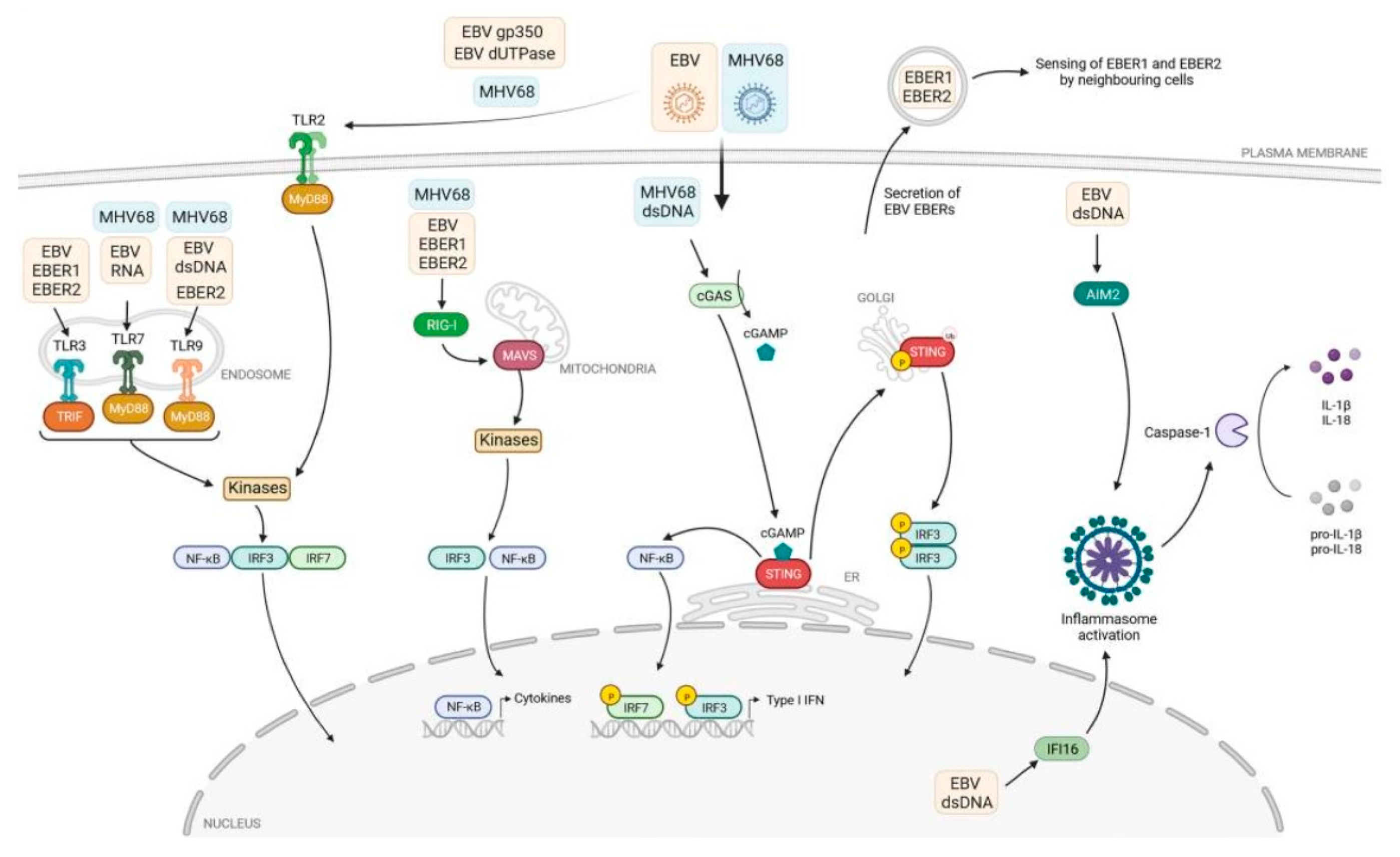
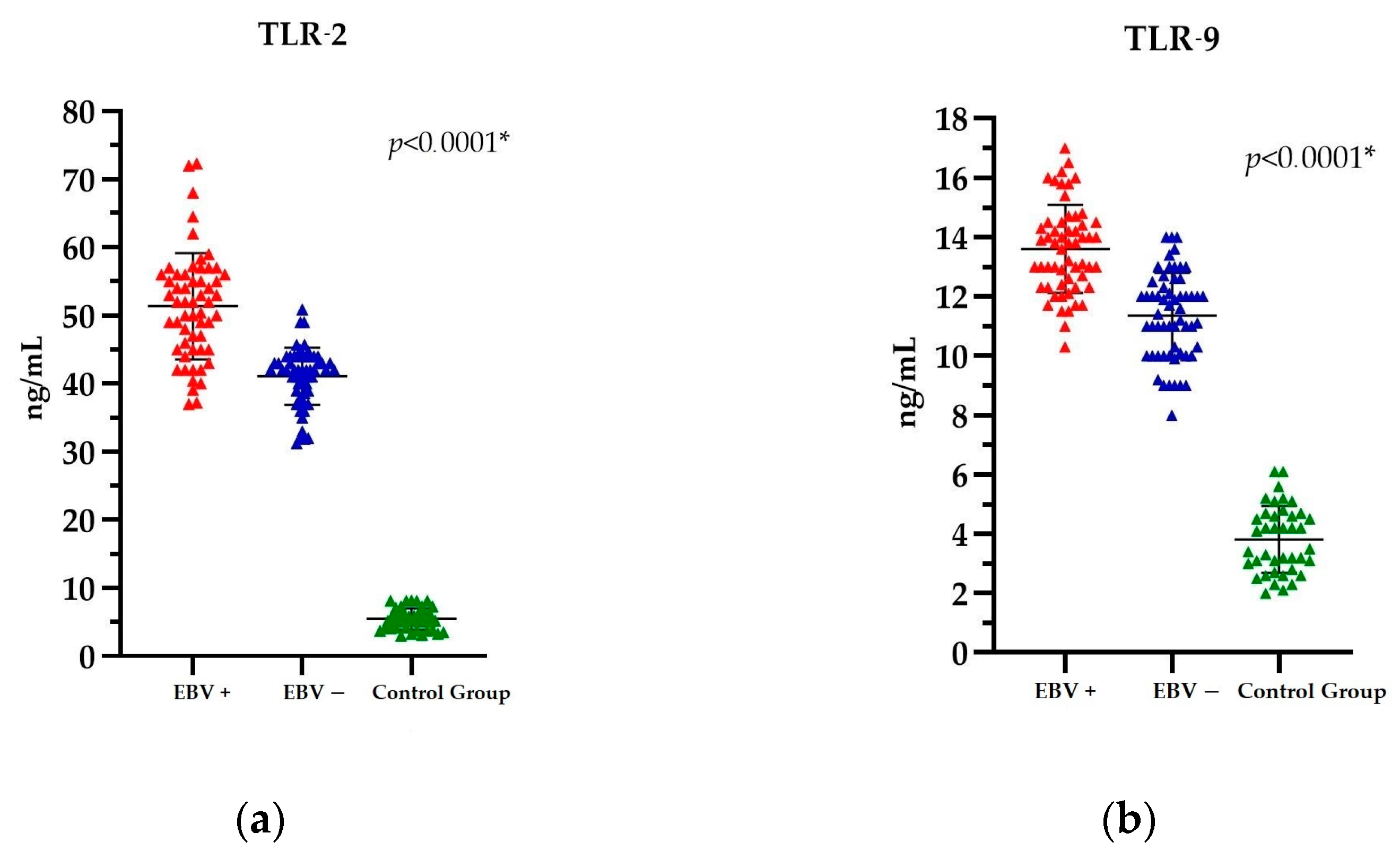
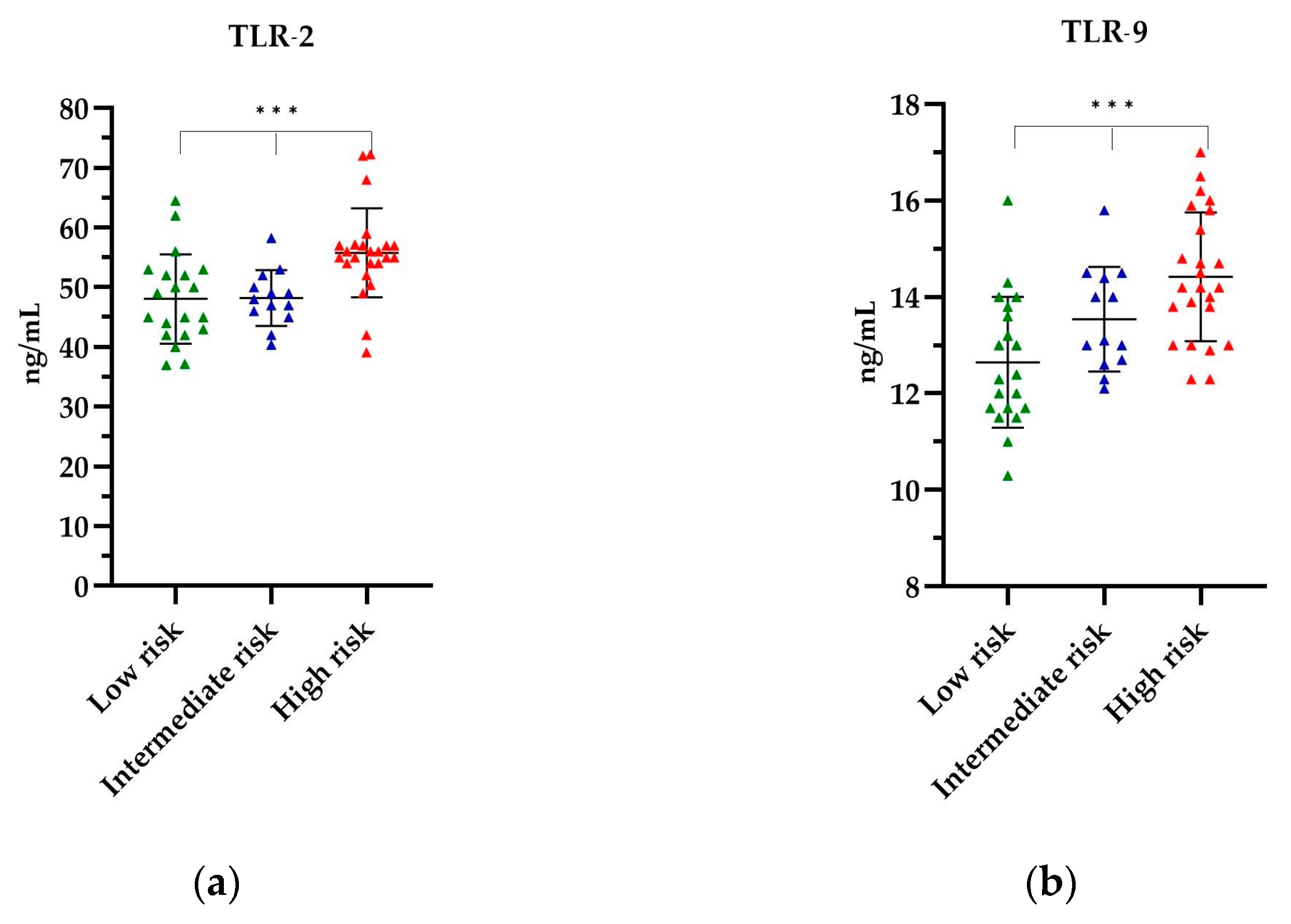
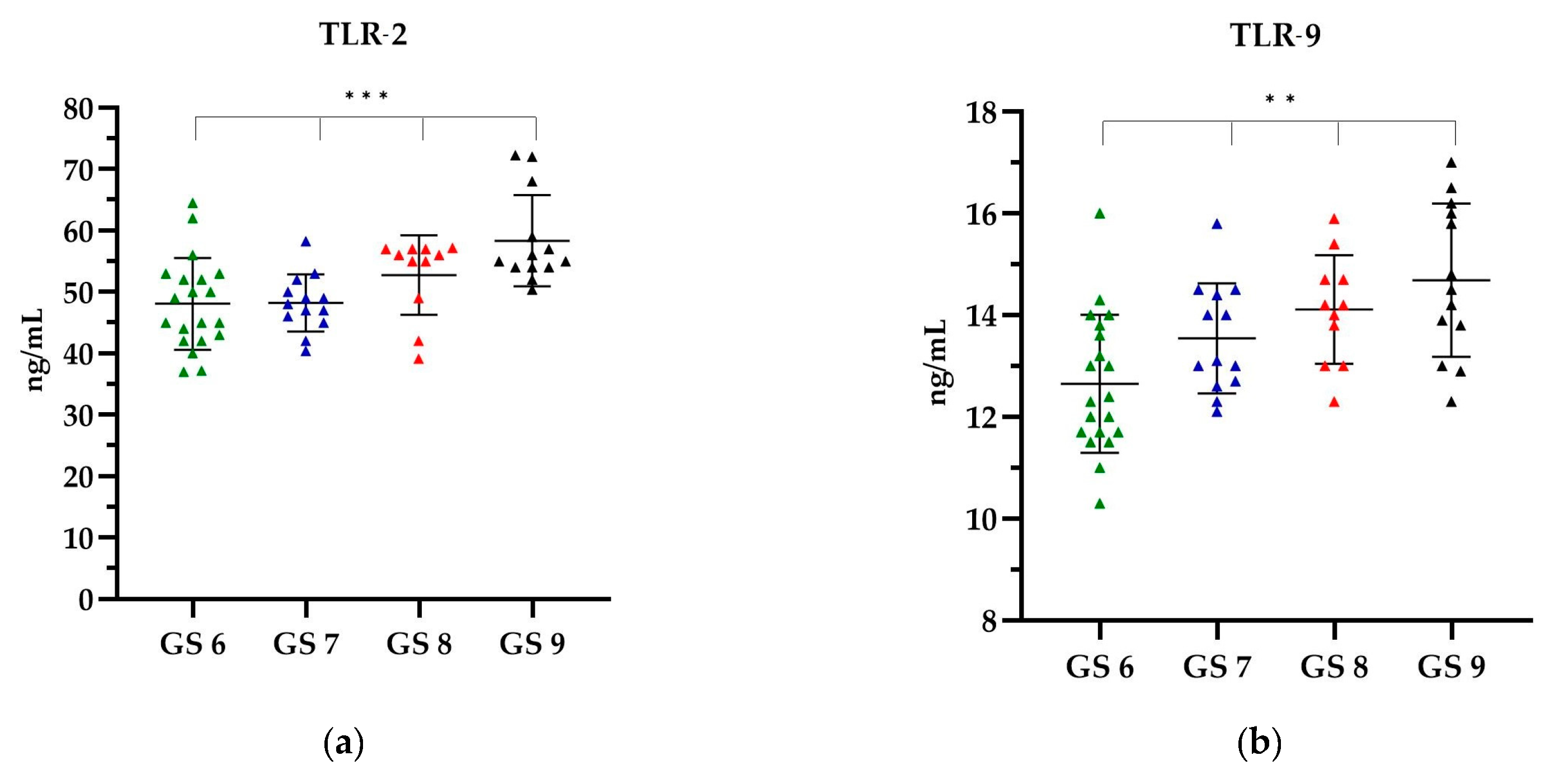
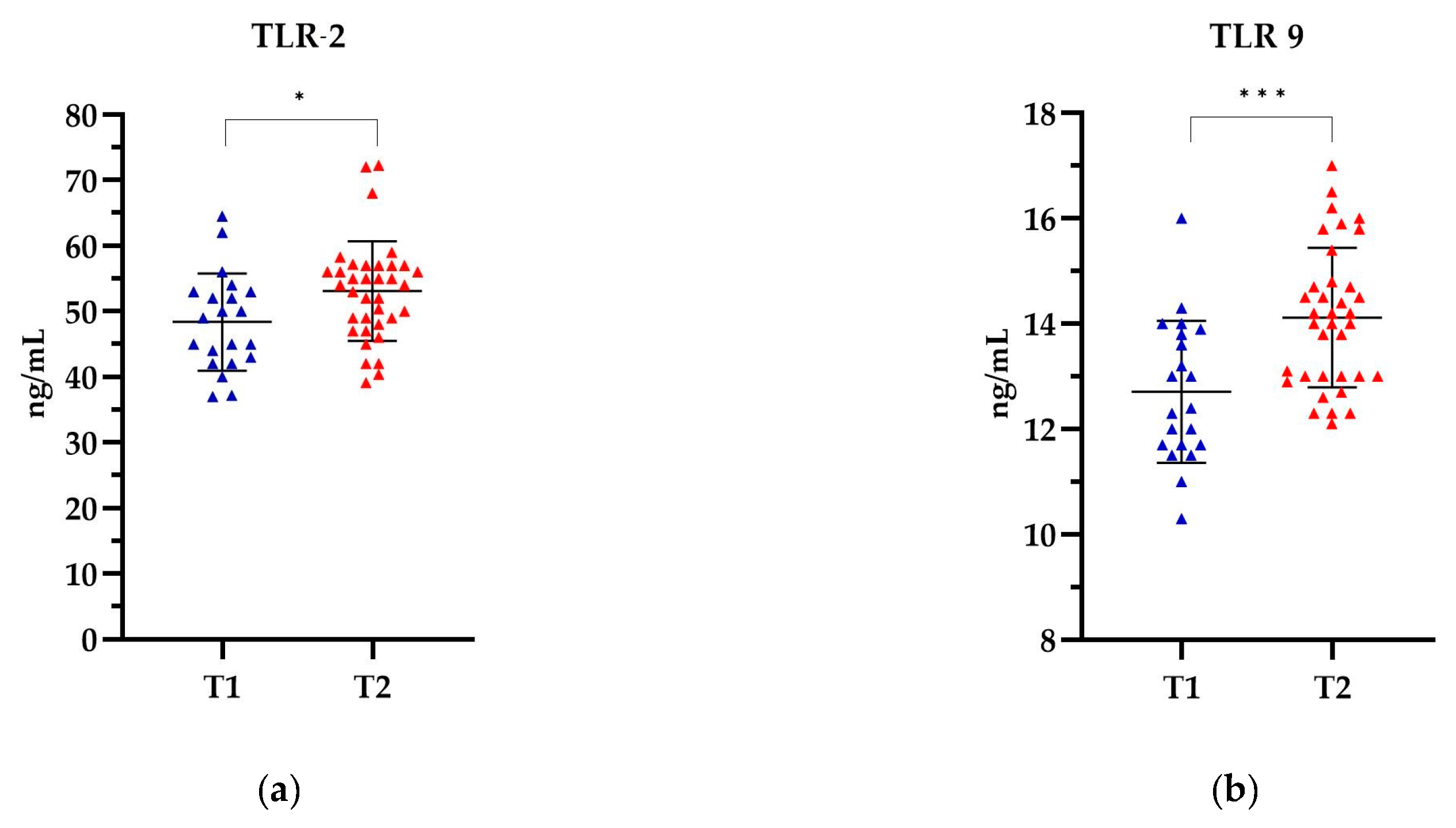
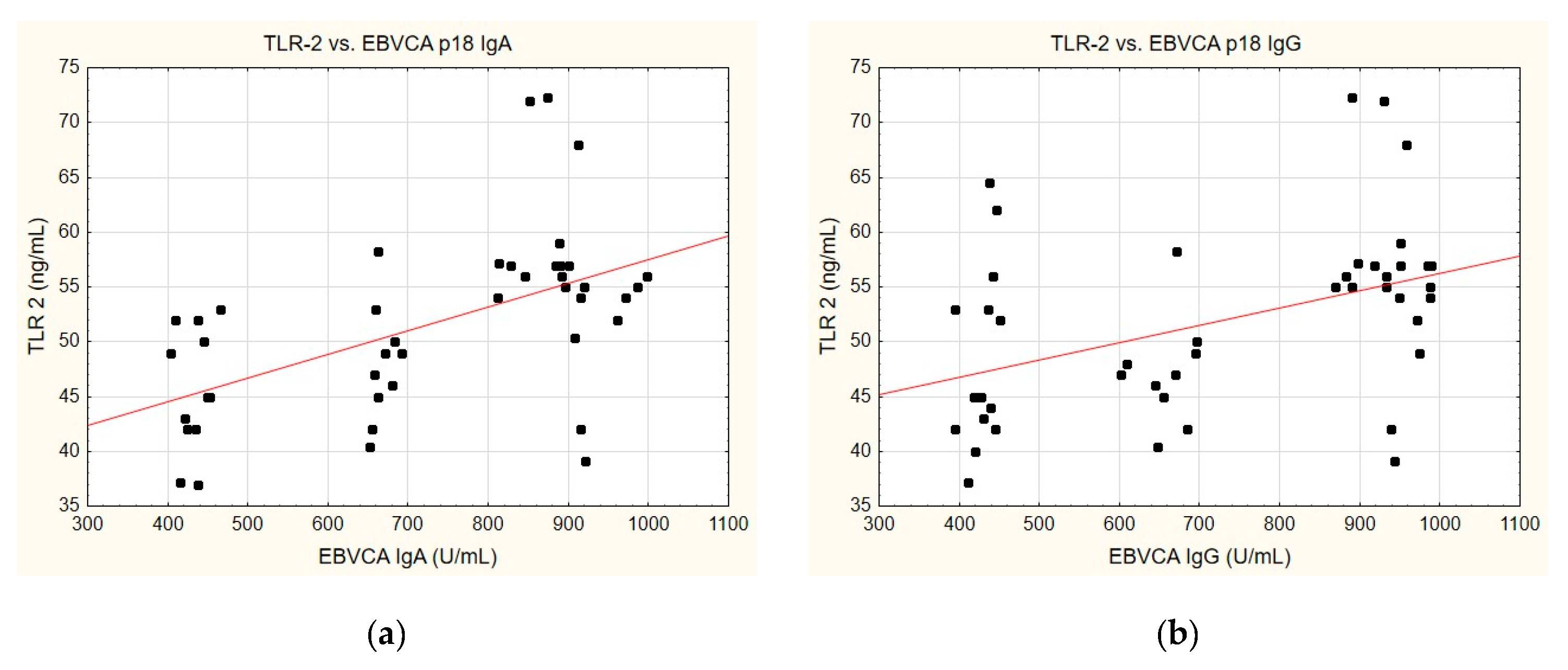


| EBV | p | Total Patients | Control Group | p | |||||||
|---|---|---|---|---|---|---|---|---|---|---|---|
| Positive (+) | Negative (−) | ||||||||||
| n | % | n | % | n | % | n | % | ||||
| Age | 54–59 | 7 | 6.09 | 11 | 9.56 | 0.3239 | 18 | 15.65 | 6 | 15.00 | 0.9218 |
| 60–82 | 50 | 43.48 | 47 | 40.87 | 97 | 84.35 | 34 | 85.00 | |||
| Place of residence | Urban | 37 | 32.17 | 31 | 26.96 | 0.2112 | 68 | 59.13 | 24 | 60.00 | 0.9232 |
| Rural | 20 | 17.39 | 27 | 23.48 | 47 | 40.87 | 16 | 40.00 | |||
| Smoking | Never | 12 | 10.43 | 10 | 8.70 | 0.6034 | 22 | 19.13 | 8 | 20.00 | 0.9046 |
| Ever | 45 | 39.13 | 48 | 41.74 | 93 | 80.87 | 32 | 80.00 | |||
| Alcohol abuse | Never | 19 | 16.52 | 20 | 17.39 | 0.4884 | 39 | 33.91 | 14 | 35.00 | 0.9653 |
| ≤drink per week | 33 | 28.70 | 36 | 31.30 | 69 | 60.00 | 24 | 60.00 | |||
| >drink per week | 5 | 4.35 | 2 | 1.73 | 7 | 6.09 | 2 | 5.00 | |||
| Risk | Low- | 20 | 35.09 | 34 | 58.62 | 0.0026 * | |||||
| Intermediate- | 13 | 22.81 | 16 | 27.59 | |||||||
| High- | 24 | 42.11 | 8 | 13.79 | |||||||
| Gleason score | 6 | 20 | 35.09 | 34 | 58.62 | 0.0052 * | |||||
| 7 | 13 | 22.81 | 16 | 27.59 | |||||||
| 8 | 11 | 19.30 | 2 | 3.45 | |||||||
| 9 | 13 | 22.81 | 6 | 10.34 | |||||||
| T | T1 | 21 | 36.84 | 33 | 56.90 | 0.0312 * | |||||
| T2 | 36 | 63.16 | 25 | 43.10 | |||||||
| T3 | 0 | 0.0 | 0 | 0.0 | |||||||
| T4 | 0 | 0.0 | 0 | 0.0 | |||||||
| N | N0 | 57 | 100.0 | 58 | 100.0 | - | |||||
| M | M0 | 57 | 100.0 | 58 | 100.0 | - | |||||
Disclaimer/Publisher’s Note: The statements, opinions and data contained in all publications are solely those of the individual author(s) and contributor(s) and not of MDPI and/or the editor(s). MDPI and/or the editor(s) disclaim responsibility for any injury to people or property resulting from any ideas, methods, instructions or products referred to in the content. |
© 2024 by the authors. Licensee MDPI, Basel, Switzerland. This article is an open access article distributed under the terms and conditions of the Creative Commons Attribution (CC BY) license (https://creativecommons.org/licenses/by/4.0/).
Share and Cite
Sikora, D.; Kiś, J.; Stępień, E.; Drop, B.; Polz-Dacewicz, M. Serum TLR2 and TLR9 in Prostate Cancer Patients in Relation to EBV Status. Int. J. Mol. Sci. 2024, 25, 9053. https://doi.org/10.3390/ijms25169053
Sikora D, Kiś J, Stępień E, Drop B, Polz-Dacewicz M. Serum TLR2 and TLR9 in Prostate Cancer Patients in Relation to EBV Status. International Journal of Molecular Sciences. 2024; 25(16):9053. https://doi.org/10.3390/ijms25169053
Chicago/Turabian StyleSikora, Dominika, Jacek Kiś, Ewa Stępień, Bartłomiej Drop, and Małgorzata Polz-Dacewicz. 2024. "Serum TLR2 and TLR9 in Prostate Cancer Patients in Relation to EBV Status" International Journal of Molecular Sciences 25, no. 16: 9053. https://doi.org/10.3390/ijms25169053





